Edited 2025.01.04 to add the HOPE accord screenshot (scroll all the way down).
“Merit is a central pillar of liberal epistemology, humanism, and democracy. The scientific enterprise, built on merit, has proven effective in generating scientific and technological advances, reducing suffering, narrowing social gaps, and improving the quality of life globally.”*
On November 26, 2004, President-elect Donald Trump nominated Prof. Jay Bhattacharya for the position of Director of the National Institutes of Health. Dr. Bhattacharya needs no introduction: he has become a minor celebrity for opposing virtually every measure aimed at curtailing COVID, including lockdowns, masking, social distancing, and vaccination. Most of the discussion surrounding his nomination for the NIH directorship focuses on his recently attained status as a COVID contrarian celebrity. While this status may have earned him the nomination, such a focus is misguided, as it overlooks the key question: what are his contributions to the broader field of biomedical sciences? What achievements make him qualified for this position? In other words, let’s talk about merit.
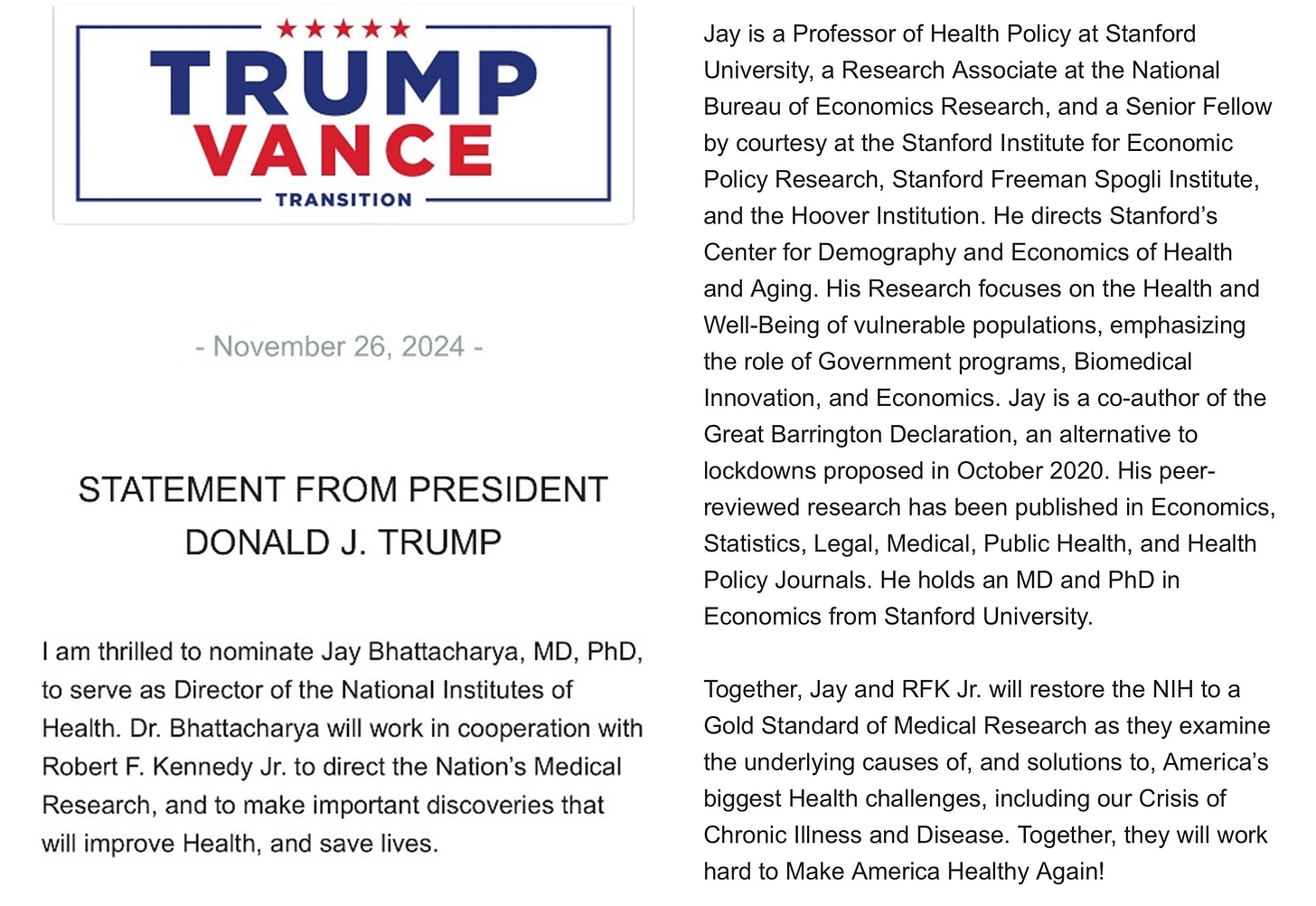
Jay Bhattacharya has never completed a residency. He is not a practicing physician. I was unable to find any evidence of board certification in any specialty. Some claim he has never treated a patient, certainly not a COVID patient. If evidence to the contrary exists, I have yet to see it presented.
His Google Scholar profile is distinctly unimpressive for someone of his rank and status. Several of his more cited papers are from the COVID era. Citation numbers are modest. I have not seen any evidence that anything he has published qualifies as a breakthrough, changed our way of thinking about something—anything, really.
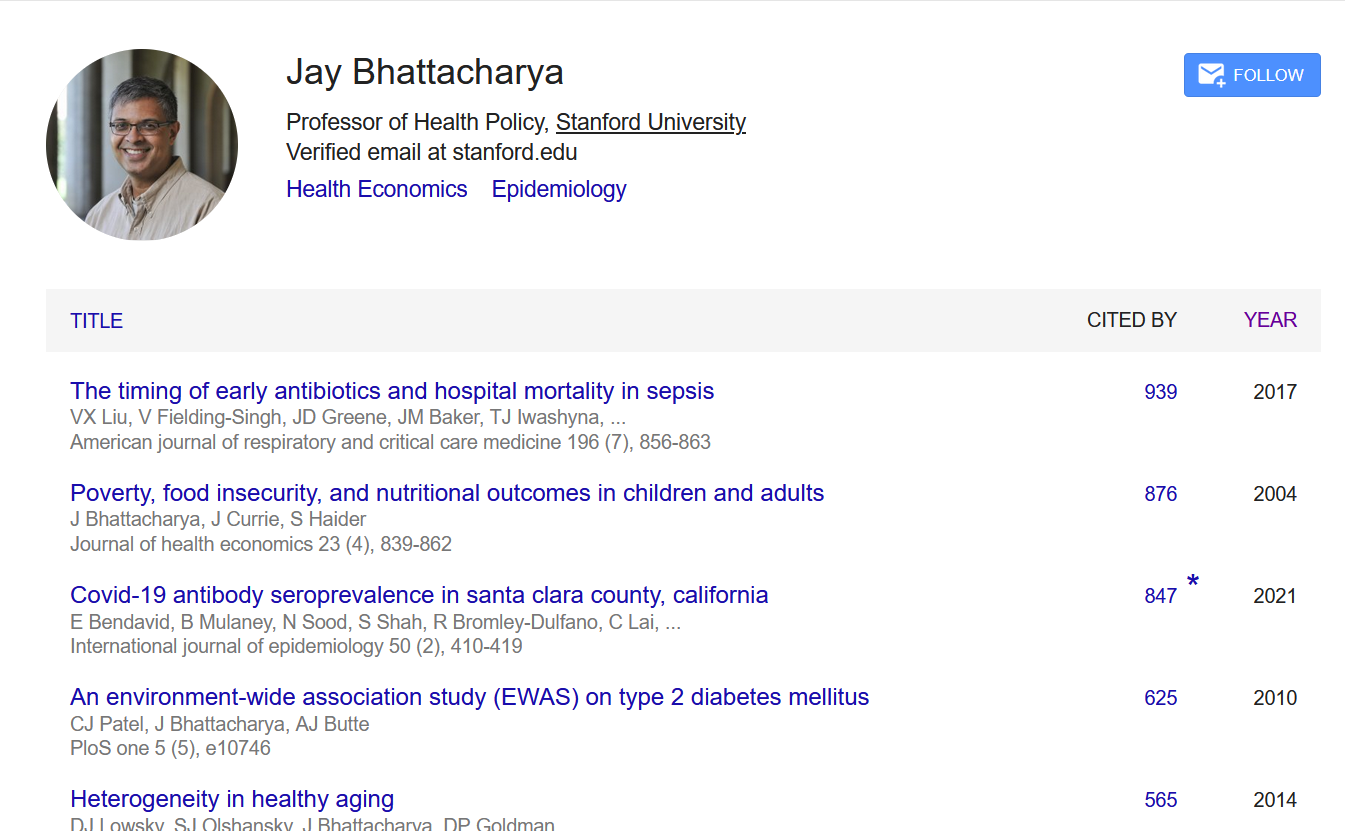
Unlike Francis Collins (the former NIH Director), Jay Bhattacharya did not lead the Human Genome Project, has not invented or developed groundbreaking DNA cloning methods (such as chromosome jumping, positional cloning) that became part of the molecular biology arsenal, was not part of a collaboration that identified the cystic fibrosis gene using tools from that arsenal. *

Note, that Collins had accomplished all of this before succeeding James D. Watson, a towering figure in genetics and molecular biology if there ever was one, as the director what subsequently became the National Human Genome Research Institute (NHGRI) in 1993.*
Unlike Francis Collins, Jay Bhattacharya did not volunteer his medical skills in a rural Nigerian hospital—he did, however, write a paper on The President's Emergency Plan for AIDS Relief in Africa: an evaluation of outcomes.*
Unlike Anthony Fauci, Jay Bhattacharya has never been “one of the world's most frequently cited scientists across all scientific journals”, nor does he have Fauci’s trail of achievements and discoveries in virology and immunology that have changed the lives of many patients.* Yet he is intensely critical of Fauci; his “Anthony Fauci: The Man Who Thought He Was Science” reveals much about Bhattacharya’s grievances. He also claims that Peter Duesberg was another victim of censorship and bullying by Fauci.
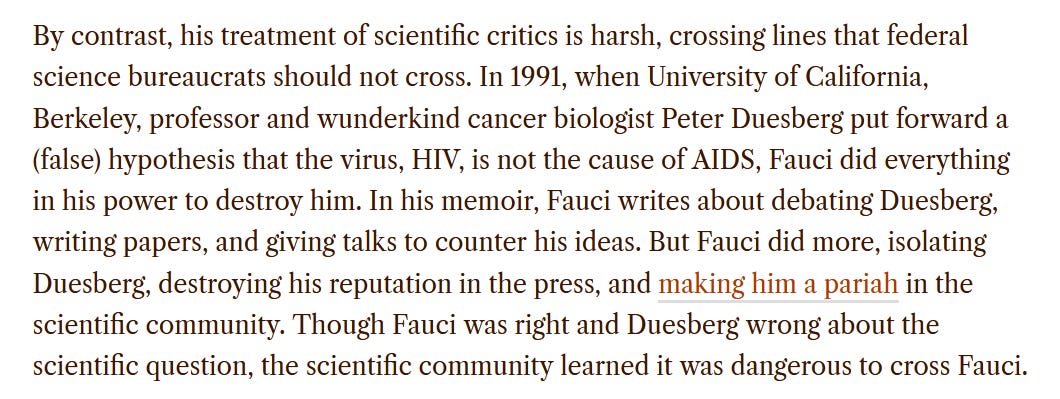
Bhattacharya was not on any of the teams that developed COVID vaccines (Corbett, McLellan, Graham for the Moderna vaccine; Weissman and Karikó (Nobel Prize in Chemistry, 2023; Weissman was Fauci’s former postdoc) for the Pfizer vaccine; Oxford Vaccine group for the AstraZeneca one). He did, however, sign the HOPE Accord calling for “The Immediate Suspension Of The Covid-19 mRNA Vaccine Products”.*1
Arguably, Bhattacharya’s greatest “contribution” to the fight against COVID was the Great Barrington Declaration he co-authored with Dr. Martin Kulldorff (Harvard) and Dr. Sunetra Gupta (Oxford)—an attempt by three unelected nobodies to hijack COVID policies in the UK and the US based on pseudoscientific notions and poor understanding of herd immunity. Thankfully, that attempt failed. This is not the place to reproduce all the arguments against the GBD. A very clear essay on the topic of herd immunity, co-authored by Fauci, can be found here. (Look carefully at the dates in the historical overview section, as this will give you an idea of how long some of these things have been known for. Basically, it was clear that GBD was nonsense when it was written). The Lancet Respiratory Medicine has also published some of the responses to the GBD, for example, that by Rochelle Walensky is concise, correct, and to the point.
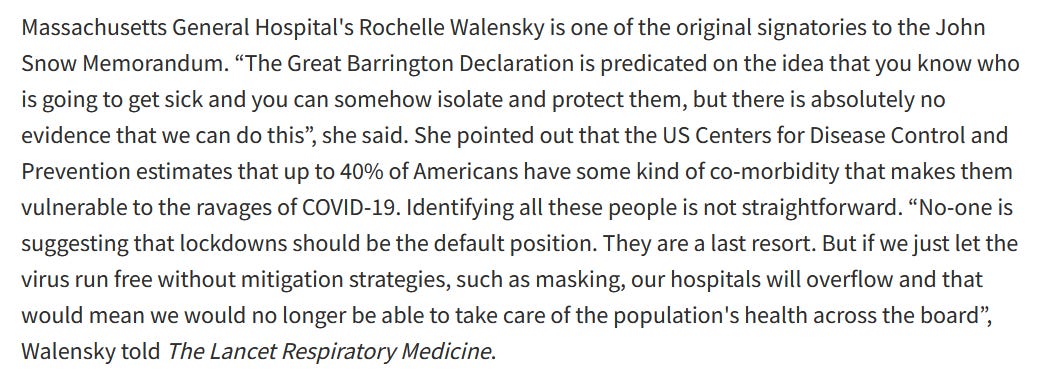
The John Snow memorandum, of which Walensky was a signatory, further points out, correctly, that a strategy based on “…the development of infection-acquired population immunity in the low-risk population is a dangerous fallacy unsupported by scientific evidence.” *
Although Bhattacharya claims he is a victim of censorship, not only was the GBD given due consideration and an open, fact-based response in the scientific literature, but it had also been examined by the policy makers, e.g., by the House of Commons's Science and Technology Select Committee in the UK, which found “fatal flaws in the argument”.* After that, of course, it was duly ignored.
On March 24, 2020, Bhattacharya published an opinion piece in the Wall Street Journal entitled Is the Coronavirus as Deadly as They Say? It contains an interesting passage: “Fear of Covid-19 is based on its high estimated case fatality rate—2% to 4% of people with confirmed Covid-19 have died, according to the World Health Organization and others. So if 100 million Americans ultimately get the disease, two million to four million could die. We believe that estimate is deeply flawed. Based on his own estimates, he goes on to predict a mortality of 0.01% and suggest “a 20,000- or 40,000-death epidemic”.
The case fatality rate, or CFR, Bhattacharya was referring to, is the number of diagnosed COVID cases divided by the number of COVID deaths. But the number of COVID cases is not the same as the number of people that have been infected by COVID, because not all people show symptoms, of those who show symptoms not everyone goes to the doctor and is diagnosed, and not everyone can be tested. The infection fatality rate, or IFR, is the number of COVID deaths divided by the total number of people infected. Early in the pandemic, it became clear that there was a significant pool of such infected but asymptomatic or otherwise undetected individuals, but estimating the number of people in that pool is challenging and it took time. Because the number of people infected is greater than the number of diagnosed COVID cases, the IFR is smaller than the CFR.
So far, so good. A systemic analysis of COVID IFR in the pre-vaccinne era can be found in The Lancet.* There, in Table 1, one can see that the 0.01% IFR predicted by Bhattacharya only matches that of the healthy under-18 year olds. Furthermore, in the Introduction of that paper, previous IFR findings are summarized, and even the most conservative estimates do not go as far down as Bhattacharya’s prediction.*, *
That study was published in 2022; hindsight is always 20/20. However, only two month after the publication of his Opinion and 4 month into the pandemic, on May 27, 2020, 100,000 Americans had died of COVID, significantly surpassing his 20 - 40k estimate. That did not stop Bhattacharya and his colleagues from publishing the GBD in October of the same year, by which time the number of deaths had doubled. As of 2024, COVID claimed the 1.1M American lives—a number a lot closer to the 2 – 4M that he so easily dismissed—and caused ~7M deaths worldwide. The problem with his estimate of COVID mortality reminds me of the 400 chest X-rays scene in Chernobyl.2

Moreover, what people seem to forget when talking about IFRs is that the revisions in the IFR estimates originate from the changes in the assessment of the total number of people infected, not the absolute numbers of deaths. As population testing became more thorough and as seroprevalence studies revealed how many people encountered the virus—regardless of whether they became symptomatic or sought medical attention—we got progressively better at estimating the total number of people who were infected. This is what led to the downward revisions of the IFRs. In other words, these lower fatality rate estimates cannot be used as an argument against containment or prevention measures; on the contrary, the downward revisions of the fatality rates suggest larger asymptomatic spreader pools than originally thought. Larger asymptomatic spreader pools would have required stricter containment and prevention measures to decrease mortality, not the other way around.
Back in 2020, there were people who had the foresight to implement such strict measures. New Zealand adopted a zero-COVID policy at the outset of the pandemic. Not only did it successfully eliminate COVID until the vaccine has arrived, but a reduction in the overall mortality was observed in 2021 and 2023. In 2022, the Omicron variant cause a spike in excess mortality, attributable to its immune escape and relaxed measures on the background of high vaccination rates.
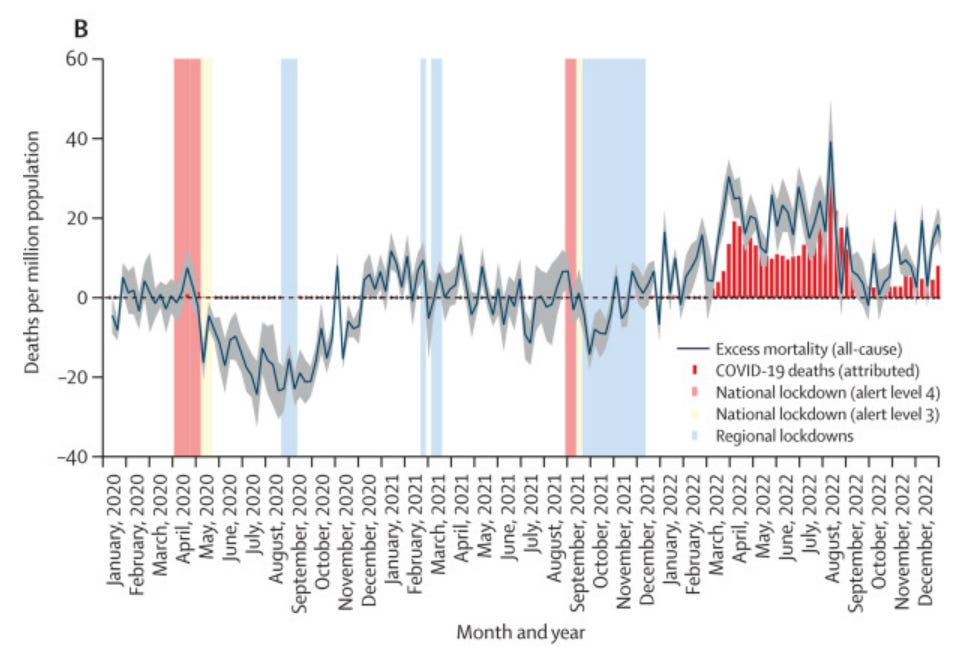
(In a sense, what happened in New Zealand in 2022 gives a significantly watered-down taste of what the world would have looked like had the policies advocated for in the GBD been adopted). New Zealand lost ~ 4k people to COVID. To help put this in perspective, this would correspond to ~ 250K deaths in the US with its 334.9M population (this number is provided here only to get the sense of scale. It is not a valid quantitative estimate because it ignores population age structure and co-comorbidities). A similar argument holds for Sweden’s ill-fated approach to COVD; see the footnote here. Yet, in 2022 (hindsight!), Bhattacharya asserted that “Zero Covid has cost New Zealand dearly” and was “a grand failure”, * the statements that he has never walked back despite several errors in that article (one of which is that while vaccination does not protect from infection, it does reduce disease severity, mortality, and spread).
In summary, until his celebrity COVID-contrarian status, Jay Bhattacharya was just another academic toiling away in relative obscurity. It comes as no surprise that he hasn’t offered any kind of vision for the future of NIH, the future that, according to him, would entail “an absolute revamping of the scientific community”. His other statements have also been political or bureaucratic in nature; e.g., he plans to “take on cancel culture”: a goal more appropriate for a DEI(-like) office than for that of the NIH Director.
He earned his celebrity status by attracting the attention of a certain political faction through statements that were critical of others, but not factually correct, and he portrays himself as a victim of the mainstream scientific community that appropriately responded to those statements. I wonder if this is starting to sound familiar. Furthermore, not only has he never corrected any of his statements (to the best of my knowledge), but on the contrary, continues to stand by the correctness of the approach outlined in the GBD and defend the non-existent evidence justifying that approach. This is not a behavior expected of a serious scientist.
Why he was nominated by Trump is clear. Less clear is the reaction to his nomination from the circles allegedly opposed to the politicization of science and focused on the restoration of merit as the basis for scientific pursuits. Since “[i]mbuing science with ideology harms the scientific enterprise and leads to a loss of public trust,”* we must stand against political forces undermining meritocracy independently of their origin. To do otherwise is just plain hypocrisy. A qualified physician scientist should be found to lead the NIH.
Edited 2025.01.04: Apparently, people are having trouble confirming Jay Bhattacharya’s signature on the HOPE accord. I used a mobile site, so I was unaware of the problems. Here is a screenshot:
To see this for yourself, either view the site on your mobile phone, or press Windows: CTRL+Shift+M / Mac: Cmd+Opt+M in Frefox (or google “viewing mobile version of the site on your desktop” in your favorite browser), scroll down to “Co-Signed By” drop-down menu, select “All”, scroll down to the Scientists & Academics frame, and within that frame, scroll down to see his name. He also talks about signing the accord here.
Something that has been bothering me about this for a long time is the timeline. The tool that helps us get a handle on the total number of infected individuals in the population, the number that is needed to calculate the IFR, is seroprevalence studies. They measure the exposure to the virus (or, later, to the vaccine) by sampling blood for the presence of antibodies against various portions of the virus across the population.
Bhattacharya published two such studies, COVID-19 antibody seroprevalence in Santa Clara County, California* (the data for this study were collected on April 3 and 4, 2020) and Seroprevalence of SARS-CoV-2–Specific Antibodies Among Adults in Los Angeles County, California, on April 10-11, 2020,* but his optimistic assessment of the mortality rate dates back to March 24th, before the data for those studies were even collected... That is why I do not agree with the assessment of Nicholas Christakis (@NAChristakis), as per the interview he gave for Cathy Young’s (@CathyYoung63) Trump NIH Pick Wants a COVID Reckoning. Christakis says that in the beginning of the pandemic, people were trying their best and some got it wrong. “This is hew science works.” Yes, it does, but science does not work by making a press announcement before you have even began the study.
Those two studies suggested seroprevalence : confirmed case ratios of 68 : 1 and 44 : 1, respectively, compared to WHO’s 34 : 1 published in the True extent of SARS-CoV-2 Infection through seroprevalence studies that was based on a meta-analysis of SARS-CoV-2 seroprevalence studies following a standardized protocol. *





